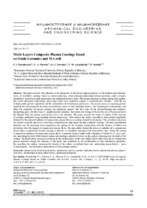| dc.contributor.author | Panteleenko, F. I. | |
| dc.contributor.author | Okovity, V. A. | |
| dc.contributor.author | Devoino, O. G. | |
| dc.contributor.author | Astashinsky, V. M. | |
| dc.contributor.author | Switala, F. | |
| dc.coverage.spatial | Минск | ru |
| dc.date.accessioned | 2022-04-06T11:11:41Z | |
| dc.date.available | 2022-04-06T11:11:41Z | |
| dc.date.issued | 2022 | |
| dc.identifier.citation | Multi-Layers Composite Plasma Coatings Based on Oxide Ceramics and M-Croll = Многослойные композиционные плазменные покрытия на основе оксидной керамики и м-кролей / F. I. Panteleenko [et al.] // Наука и техника. – 2022. – № 2. – С. 93-98. | ru |
| dc.identifier.uri | https://rep.bntu.by/handle/data/110955 | |
| dc.description.abstract | The paper considers the influence of the parameters of the plasma spraying process on the technological characteristics of multilayer coatings based on nickel-chromium, nickel-chromium-aluminum-yttrium materials, oxide ceramics, intended for operation at high temperature and additional dynamic loads. The design of plasma coatings during their application (with subsequent high-energy processing) under such conditions requires a comprehensive solution – both the use of high-quality powder ingredients and the optimization of technological parameters. The plasma process of applying powder materials has been improved to obtain the maximum values of their utilization factors. The technological characteristics that affect the properties of plasma coatings are optimized, namely: the flow rates of the plasma-forming and materialstransporting gases, the flow rate of supplied powder materials, the current and voltage of the electric arc of the plasma torch, the distance from the plasma torch nozzle exit to the substrate. The paper presents the results of studies of the structure of coatings, performed using scanning electron microscopy. Their analysis has made it possible to form general regularities obtained by the action of radiation of compression plasma flows on coatings formed by air plasma. The considered structures are created using the processes of melting, compaction and high-speed cooling of plasma coatings. The main optimization indicators are the maximum local compaction and spillage of the obtained compositions with the absence of defects and destruction from the impact of compression plasma flows. The main effect during the action of radiation of a compression plasma flow on previously formed coatings is thermal. It contributes heating of the near-surface layer. When the coating is exposed to radiation of compression plasma flows, a remelted layer of oxides with a thickness of about 12–15 μm is created, smoothing the relief of the formed surface and creating a network of cracks on the surface, diverging into the depth of the coating. The liquid-phase processes occurring in the molten phase of the near-surface layers after exposure to compression plasma radiation change the structure of the layers and contribute to the modification of their mechanical properties. By smoothing the surface, increasing the density of the surface crystallized layer and minimizing macro-defects – pores or macrocracks – the mechanical characteristics of the coatings increase. | ru |
| dc.language.iso | en | ru |
| dc.publisher | БНТУ | ru |
| dc.title | Multi-Layers Composite Plasma Coatings Based on Oxide Ceramics and M-Croll | ru |
| dc.title.alternative | Многослойные композиционные плазменные покрытия на основе оксидной керамики и м-кролей | ru |
| dc.type | Article | ru |
| dc.identifier.doi | 10.21122/2227-1031-2022-21-2-93-98 | |
| local.description.annotation | Рассмотрено влияние параметров процесса плазменного напыления на технологические характеристики многослойных покрытий на базе материалов никель-хром и никель-хром-алюминий-иттрий, оксидной керамики, предназначенных для эксплуатации при высоких температурных и дополнительных динамических нагрузках. Конструирование плазменных покрытий при их нанесении (с последующей высокоэнергетической обработкой) в таких условиях требует комплексного решения – как применения качественных порошковых ингредиентов, так и оптимизации технологических параметров. Усовершенствован плазменный процесс нанесения порошковых материалов для получения максимальных значений их коэффициентов использования. Оптимизированы технологические характеристики, оказывающие влияние на свойства плазменных покрытий, а именно: величины расходов плазмообразующего и транспортирующего материалы газов, расход подаваемых порошковых материалов, ток и напряжение электрической дуги плазменной горелки, расстояние от среза сопла плазмотрона до подложки. В статье приведены результаты исследований структуры покрытий, выполненных с применением растровой электронной микроскопии. Их анализ позволил сформировать общие закономерности, получаемые при воздействии излучения компрессионных плазменных потоков на сформированные воздушной плазмой покрытия. Рассмотренные структуры созданы при помощи процессов плавления, уплотнения и высокоскоростного охлаждения плазменных покрытий. Основные показатели оптимизации – максимальное локальное уплотнение и проплавление полученных композиций с отсутствием дефектов и разрушений от воздействия потоков компрессионной плазмы. Главный эффект при воздействии излучения компрессионного плазменного потока на ранее сформированные покрытия – тепловой. Он способствует нагреву приповерхностного слоя. При действии на покрытия излучения компрессионных плазменных потоков создается переплавленный слой оксидов толщиной порядка 12–15 мкм, сглаживающий рельеф сформированной поверхности и создающий на поверхности сетку трещин, расходящихся в глубину покрытия. Происходящие в расплавленной фазе приповерхностных слоев жидкофазные процессы после воздействия излучения компрессионной плазмы изменяют структуру слоев и способствуют модификации их механических свойств. Благодаря сглаживанию поверхности, увеличению плотности поверхностного закристаллизованного слоя и минимизации макродефектов – пор или макротрещин – повышаются механические характеристики покрытий. | ru |

